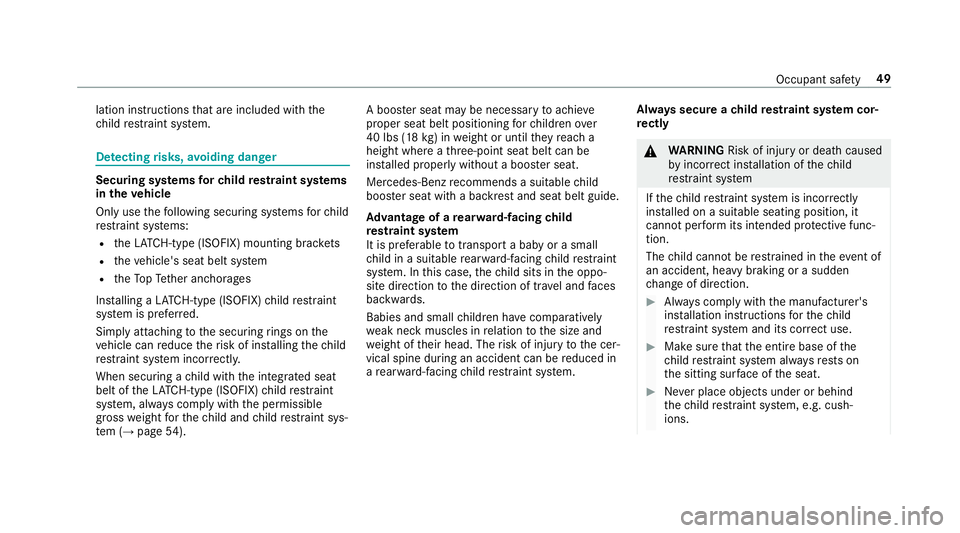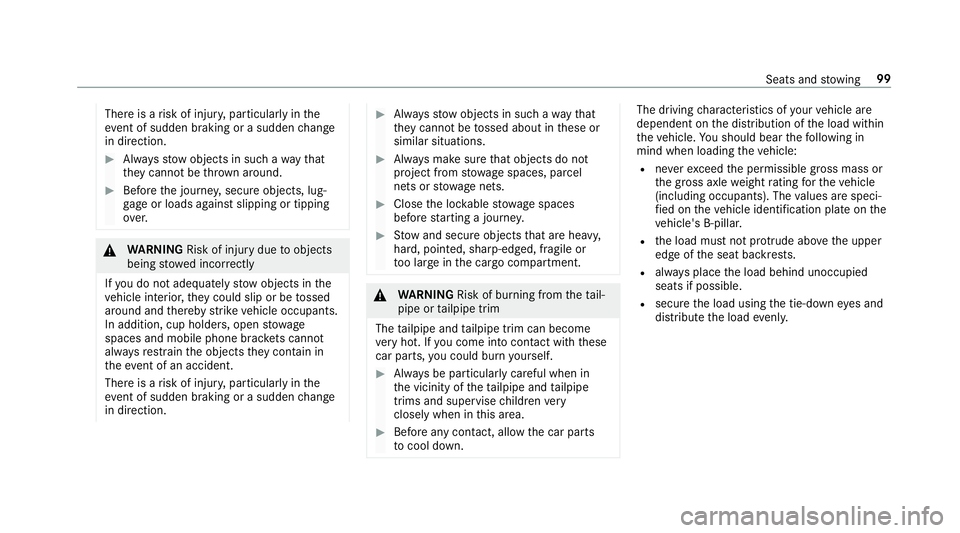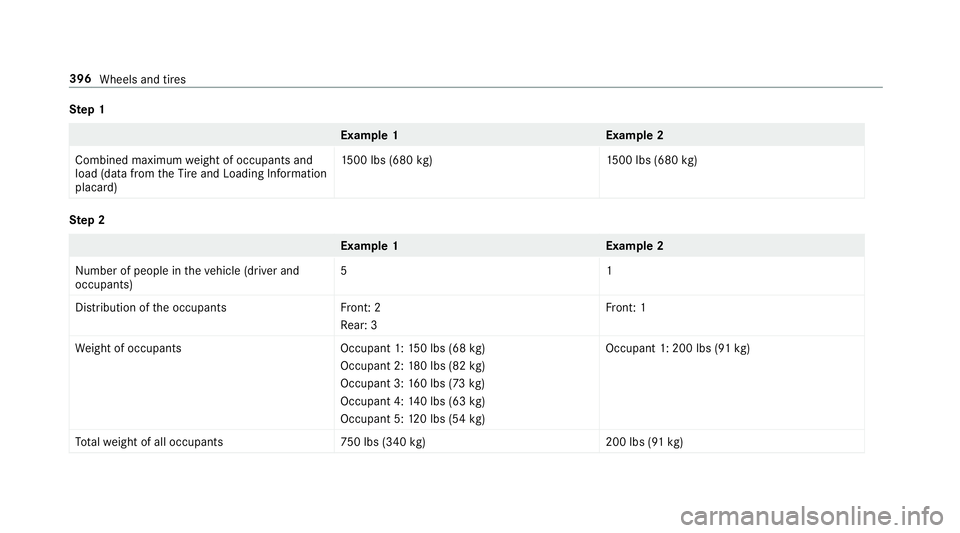2019 MERCEDES-BENZ AMG GT 4-DOOR COUPE weight
[x] Cancel search: weightPage 27 of 530

*
NO
TEBatt erydi sc ha rging from using
de vice sconne cted tothediagnos tics
con nect ion Using
devices atthediagnos ticsconnect ion
dr ains thebatt ery. #
Chec kth ech arge leve lof thebatt ery. #
Ifth ech arge leve lis low, charge the
batt ery, e.g. bydriving acon sider able
dis tance. Co
nnecti ngequip ment tothediagnos ticscon‐
nect ioncan lead toemissions monitoring infor‐
mation beingrese t,forex am ple. This maylead
to theve hicle failing tomee tth ere qu iremen tsof
th ene xt emissions inspectionduring themain
inspect ion. Qualif
iedspecialis two rkshop
An author ized Mercedes-B enzCent erisaqu ali‐
fi ed specialis two rkshop. Ithas theneces sary
special skills,tools and qualif icat ionsto cor‐
re ctly carryout thewo rkrequ ired on your vehi‐ cle.
This particular lyapplies tosaf ety-re leva nt
wo rks.
Fo rth efo llo wing, alwaysha ve your vehicle
ch eckedat an aut hor ized Mercedes- BenzCen‐
te r:
R safety-re leva nt wo rks
R service andmaint enance work
R repair work
R modif ications aswellas installation sand
con versions
R workon electr oniccomponent s
Mer cedes‑A MGrecomme ndsaMercedes‑Be nz
ser vice center. Co
rrect use oftheve hicl e
If yo ure mo veanywa rning sticke rs,yo uor other s
could failto recogni zecer tain dang ers. Lea ve
wa rning sticke rs inposit ion.
When usingtheve hicle, observethefo llo wing
inf ormatio n:
R thesaf etyno tesin this manual R
tech nica lda ta forth eve hicle
R traf fic ru les and regulations
R laws and safetyst andar dsper tainin gto
mo torve hicles Inf
ormat ionontheREA CHregulat ion
The REACHRegulation (Regulation (EC)No.
19 07 /2006, Article 33)stipulat esan informa‐
tion oblig ation forsubs tances ofvery high con‐
cer n(S VHC).
Daimler AGisact ing tothebes tof its know ledg e
to avo idtheuse and application ofthese SVHCs
and toenable thecus tomer tohandle theses
subs tances safely.Ac cor ding tosuppli erinfor‐
mation andinternal product information of
Daimler AG,SV HCs arekno wnwhicharemor e
th an 0.1 per cen tby weight inindiv idual product s
of this vehicle.
Fu rther information canbefound at:
R http :/ /www .daimler .com/ reac h
R http :/ /www .daimler .com/ reac h/e n Gene
ralno tes 25
Page 45 of 530

#
The entir ebase ofthech ild restra int
sy stem mus talw aysre st on thesitt ing
sur face ofthefront passeng erseat. #
The backres tof thefo rw ard-f acin gch ild
re stra int system mus t,as faras possi ‐
ble, beresting ontheseat backres tof
th efront passeng erseat. #
Alw ayscom plywit hth ech ild restra int
sy stem manuf acturer'sinstallation
ins truct ions . A
per son onthefront passeng erseat must
obser vethefo llo wing informatio n:
R Fasten seat belts correctl y(→ page 35).
R Sitinan almos tupr ight seatposi tion with
th eir bac kag ains tth eseat backres t.
R Sitwithth eir feet resting onthefloor ,if pos‐
sible.
The front passeng erfront airbag mayot her wise
be deactiv ated bymis take ,fo rex am ple inthe
fo llo wing situat ions:
R The front passen gertr ansf ersth eir weight by
suppor tingthemselv eson ave hicle armr est. R
The front passeng ersits insuc hawa yth at
th eir weight israised from thesitt ing sur‐
fa ce. &
WARNIN GRisk ofinju ryor deat hdue to
deactiv ated front passeng erairbag
If th ePA SSENGER AIRBAGOF Find icat or
lam pis lit,th efront passeng erairbag isdisa‐
bled. Itwill notbe deplo yedin theeve ntof
an acci dent and canno tpe rfor m its intended
pr otect ive func tion.
A per son inthefront passeng erseat could
th en, forex am ple, com eint ocon tact with
th eve hicle interior ,especially ifth eper son is
sitt ing tooclose tothecoc kpit.
If th efront passeng erseat isoccupied,
alw aysensur eth at:
R The classificat ion oftheper son inthe
fr ont passeng ersea tis cor rect and the
fr ont passeng erairb agisenabl edordisa ‐
ble din accor dance withth eper son inthe
fr ont passeng ersea t. R
The front passeng ersea thas been moved
as farbac kas possi ble.
R The person isseat edcor rectl y. #
Ensu re,bo th bef oreand during thejour‐
ne y,that thest atus ofthefront
passeng erairbag iscor rect. If
th efront passeng erseat isoccupied, theclas‐
sif ication oftheper son orchild restra int system
on thefront passeng erseat take splace afte rth e
fr ont passeng erfront airbagshut offself-t est.
The PASSENGER AIRBAGind icat orlam psdis‐
pla yth est atus ofthefront passeng erfront air‐
bag.
Alw aysobser vetheno teson thefunc tion ofthe
PA SSENGER AIRBAGind icat orlam ps
(→ pag e44 ). Occ
upant safety 43
Page 51 of 530

lation
instruct ions that areinc luded withth e
ch ild restra int system. De
tectin grisk s,avo iding danger Secur
ingsystems forch ild restra int systems
in theve hicl e
Only usethefo llo wing secur ingsystems forch ild
re stra int systems:
R theLA TC H-type (ISOFIX )mou nting brac kets
R theve hicle's seatbeltsystem
R theTo pTe ther anc horages
Ins talling aLA TC H-type (ISOFIX )ch ild restra int
sy stem isprefer red.
Sim plyattaching tothesecur ingrings onthe
ve hicle canreduce therisk ofins talling thech ild
re stra int system incor rectly .
Whe nsecu ring ach ild withth eint egr ated seat
belt oftheLA TC H-type (ISOFIX )ch ild restra int
sy stem, alwayscom plywit hth eper missible
gr oss weight forth ech ild and child restra int sys‐
te m (→ pag e54 ). A
boos terseat maybe necessar yto achie ve
pr oper seatbeltposition ingforch ildr enove r
40 lbs (18 kg )in we ight orunt ilth ey reac ha
heigh twher eath re e-point seatbeltcanbe
ins talled proper lywit hout aboos terseat.
Mer cedes-Benz recomme ndsasu itab lech ild
boos terseat withabac kres tand seat beltguide.
Ad vantag eof are ar wa rd-faci ng child
re stra int system
It is prefer able totrans portabab yor asmall
ch ild inasuit able rear wa rd-faci ng child restra int
sy stem. Inthis case, thech ild sits intheoppo‐
sit edir ect ion tothedir ect ion oftra veland faces
ba ckwa rds.
Babies andsmall childr enhave com parativ ely
we ak nec kmusc lesinrelation tothesize and
we ight oftheir head. Therisk ofinjur yto thecer‐
vical spine during anacciden tcan bereduced in
a re ar wa rd-faci ng child restra int system. Alw
ayssecur each ild restra int system cor‐
re ctl y &
WARNIN GRisk ofinju ryor deat hcaused
by inc orrect ins tallation ofthech ild
re stra int system
If th ech ild restra int system isincor rectly
ins talled onasuit able seatin gposit ion,it
can notper form itsintended protect ive func ‐
tion .
The child can notbe restra ined intheev ent of
an acciden t,hea vybraking orasudden
ch ang eof dir ect ion. #
Alw ayscom plywit hth emanuf acturer's
ins tallation instruct ions forth ech ild
re stra int system and itscor rect use. #
Makesur eth at theent ire base ofthe
ch ild restra int system alwaysre stson
th esitt ing surface oftheseat. #
Neverpla ceobjects underorbehi nd
th ech ild restra int system, e.g.cush‐
ions. Occ
upant safety 49
Page 101 of 530

Ther
eis arisk ofinjur y,par ticular lyin the
ev ent ofsudden braking orasudden chang e
in dir ect ion. #
Alw aysst ow object sin suc hawa yth at
th ey canno tbe thro wn around . #
Beforeth ejour ney,secur eobjects, lug‐
ga ge orloads agains tslipping ortipping
ove r. &
WARNIN GRisk ofinju rydue toobject s
being stowe dincor rectl y
If yo udo notadeq uatelyst ow object sin the
ve hicle interior ,th ey cou ldslipor be tossed
ar ound andther eb yst rike vehicle occupants.
In addition, cupholder s,open stow age
spac esand mobi lephon ebr ac kets cann ot
alw aysre stra in theobjec tsthey cont ain in
th eev ent ofan acciden t.
Ther eis arisk ofinjur y,par ticular lyin the
ev ent ofsudden braking orasudden chang e
in dir ect ion. #
Alw aysst ow object sin suc hawa yth at
th ey canno tbe tossed about inthese or
similar situation s. #
Alw aysmak esur eth at obj ect sdo not
pr oject from stow agespac es,parcel
ne ts or stow agene ts. #
Close theloc kable stow agespac es
bef orest ar tin gajo ur ne y. #
Stow and secureobj ect sth at arehea vy,
har d,poin ted, shar p-edg ed,fragile or
to olar ge inthecar gocom partmen t. &
WARNIN GRisk ofburning from theta il‐
pipe ortailpipe trim
The tailpipe andtailpipe trim can becom e
ve ry hot.Ifyo uco me intoco ntact withth ese
car parts,youco uld burnyo urself . #
Alw aysbe par ticular lycareful whenin
th evicinit yof theta ilpipe andtailpipe
tr ims and super visechildr envery
clos elywhe nin this area. #
Beforean ycon tact, allo w thecar parts
to cool down. The
drivi ng charact eristic sof your vehicle are
dependent onthedis tribution oftheload within
th eve hicle. Yousho uld bear thefo llo wing in
min dwhen loading theve hicle:
R neverex ceed theper missible gross mass or
th egr oss axle weight rating forth eve hicle
(including occupants). Thevalues arespec i‐
fi ed on theve hicle identif ication plateon the
ve hicle's B-pillar.
R theload mustno tpr otru de abo vetheupper
edg eof theseat backres ts.
R alwaysplace theload behind unoccupied
seats ifpossible.
R secur eth eload using thetie-do wneyes and
dis tribut eth eload evenly. Sea
tsand stow ing 99
Page 381 of 530

To
wing theve hicl ewith both axle son the
gr ound #
Obser vetheno teson theper mitt edtowing
me thods (→pag e37 7). #
Makesur eth at thebatt eryis con nect edand
ch arge d.
Obser vethefo llo wing pointswhen thebatt eryis
disc harged:
R The engin ecann otbe star ted
R The electr icpar king brak ecann otbe
re leased orapplied
R Vehicl eswith automatic transmiss ion:
The automatic transmiss ioncanno tbe shif‐
te dto position 005Cor005D.
% Vehicl eswith automatic transmiss ion:If
th eaut omatic transmiss ioncann otbe shif‐
te dto position 005C,orthemultifunc tiondis‐
pla yin theins trument clusterdoes notsho w
an ything, have theve hicle transpor tedaw ay
( → pag e380). Atowing vehicle withlifting
eq uipment isrequ ired forve hicle transpor ta‐
tio n. *
NO
TEDama gedue totowing away at
exc essiv elyhigh speeds orover long dis‐
ta nces The
drivet ra in could bedamag edwhen tow‐
ing atexc essiv elyhigh speeds orover long
dis tances. #
Atowing speed of30 mph(50 km/h)
mus tno tbe exc eeded. #
Atowing distance of30 miles(50 km)
mu stnotbe exc eeded. &
WARNIN GRisk ofacci dent whento wing
a ve hicle whichis toohea vy
If th eve hicle being tow- star tedor towe d
aw ay ishea vier than theper missible gross
mass ofyour vehicle, thefo llo wing situat ions
can occur:
R The towing eyema ybecome detach ed.
R The vehicle/tr ailercombination may
sw erve oreve nov ertur n. #
Ifano ther vehicle istow- star tedor
to we daw ay,its weight mustno texc eed th
eper missible gross mass ofyour ow n
ve hicle. If
ave hicle mustbe tow star tedor towe daw ay,
its per missib legross mass mustno texc eed the
per missible gross mass oftheto wing vehicle. #
Information ontheper missible gross mass of
th eve hicle canbefound ontheve hicle iden‐
tif ication plate(→ pag e41 8). #
Vehicl eswith automatic transmiss ion:Do
no topen thedr iver's door orfront passeng er
door ,ot her wise theaut omatic transmiss ion
aut omaticall yshif tsto position 005D. #
Installing theto wing eye(→ pag e38 1). #
Fasten theto w bar .
* NO
TEDama gedue toinc orrect connec‐
tion #
Onlyconnect theto w rope ortow bar to
th eto wing eyes. #
Deact ivating theaut omatic locking mecha‐
nism (→pag e70). Br
eakdo wnassis tance 37
9
Page 396 of 530

im
pair thesteer ing and handling charact eris‐
tic sand lead tobrak efa ilur e. #
Obser vetheload-bear ingcapacity of
th etir es. #
The load-bear ingcapacity mustbe at
leas thalf thegr oss axle weight rating of
th eve hicle. #
Neverove rload thetir es by exc eeding
th emaximum load. The
Tire and Loadi ngInfo rm atio nplacar dis on
th eB-pillar onthedr iver's side oftheve hicle. 1
Tire and Loadi ngInfo rm atio nplacar d %
The datasho wnintheillus tration isexam ple
dat a.
The Tire and Loadi ngInfo rm atio nplacar dsho ws:
R Maximum numberofseats 2accor dingto
th emaximum numberofpeople permitt edto
tr ave lin theve hicle.
R Maximum permissible load3com prises the
gr os swe ight ofall vehicle occupants, load
and luggage. R
Recomme ndedtirepr ess ures 1 forcold
tir es. The recomme ndedtirepr ess ures are
va lid forth emaximum permissible loadand
up tothemaximum permissible vehicle
speed.
Please alsonote:
R Information onper missib lewe ight sand loads
on theve hicle identif ication plate
(→ pag e41 8).
R Informatio non tirepr essu reinthetir epr es‐
sur eta ble (→pag e389 ).
Fu rther relat ed subje cts:
R Determ inin gth emaximum permissible load
(→ pag e39 4)
R Noteson tirepr essur e(→ pag e388). De
term ining thema xim um permis sible load The
follo wing steps have been developed as
re qu ired ofall manuf acturersunder Title 49,
Co de ofU.S. Feder alRe gulations, Part57 5, pur‐
sua nttothe"N ational Traf fic and MotorVe hicle
Saf etyAc tof 1966". 39
4
Whee lsand tires
Page 397 of 530

#
Ste p1: loca tethest at emen t"The combined
we ight ofocc upant sand load should never
exc eed XXX kgorXXX lbs." ("The combined
we ight ofocc upant sand load should never
exc eed XXX kgorXXX lbs.") onyour vehicle's
Ti re and Loadi ngInfo rm atio nplacar d. #
Ste p2: determ ine thecombin edweight of
th edr iver and passeng ersth at will betravel‐
ing inyour vehicle. #
Ste p3: subtr act thecombin edweight ofthe
dr iver and passeng ersfrom XXX kgor
XXX lbs. #
Ste p4: there sulting figur eeq uals theper‐
missible cargoand luggageload capacity .Fo r
ex am ple: If"XXX "eq uals 1400 lbs and ther e
ar efive occupant sin your vehicle witha
we ight of150lbs eac h,themaximum cargo
and luggageload capacity is650 lbs(1400 -
75 0(5 x15 0) =650 lbs). #
Ste p5: determ ine thecombin edweight of
lugg ageand load that theve hicle willbecar‐ ry
ing. Forsaf etyre ason s,this we ight mayno t
saf elyexc eed theav ailable cargoand lug‐
ga ge load capac itycalc ulatedinstep 4.
Ev en ifyo uha ve cal cul ated thetot alload care‐
full y,yo usho uld still mak esur eth at themaxi‐
mum permissible gross mass andthemaximum
per missible axleload ofyour vehicle areno t
exc eeded. Details can befound ontheve hicle
identif ication plate. #
Have your loaded vehicle –including driver ,
occupants andload –we ighed onave hicle
we ighbr idge.
The measur edvalues mayno texc eed the
maximu mper missi blevalues stat ed on the
ve hicle identif ication plate.
Fu rther relat ed subje cts:
R Calculation exam ple forde term inin gth emax‐
imum load(→pag e395)
R Tire and Loadi ngInfo rm atio nplacar d
(→ pag e39 3) R
Tire pressur eta ble (→pag e389 )
R Vehicle identif ication plate Calculation
exam ple forde term ining the
ma ximum load The
follo wing table showsexam ples ofhowto
cal cul ateto ta land load capac itieswithva rying
seatin gcon figur ations anddiffere nt num bers
and sizes ofocc upant s.The follo wing exam ples
use amax imum loadof1500 lbs (680 kg).This
is forillus tratio npur pos esonly.Mak esur e
yo uar eusin gth eactual loadlimit foryo ur vehi‐
cle stat ed on your vehicle's Tire and Loadi ng
In fo rm atio nplacar d(→ pag e39 3).
The high erthewe ight ofall theoccupant s,the
smaller themaximum loadforlug gage . Wheels
andtires 395
Page 398 of 530

Ste
p1 Ex
am ple 1E xamp le2
Combine dmaxim umweight ofocc upant sand
load (datafrom theTire and Loadi ngInfo rm atio n
placar d) 15
00 lbs (680 kg)1 500lbs(680 kg) Ste
p2 Ex
am ple 1E xamp le2
Nu mb erofpeople intheve hicle (driver and
occupants) 51
Dis trib uti on oftheoccupant sF ront:2
Re ar:3 Fr
ont :1
We ight ofocc upant sO ccupant1:150lbs (68 kg)
Occupant 2:180lbs (82 kg)
Occupant 3:160lbs (73 kg )
Occupant 4:140lbs (63 kg)
Occupant 5:120lbs (54kg ) Occupant
1:200 lbs(91 kg )
To talwe ight ofall occ upant s7 50lbs (340 kg)2 00lbs (91 kg ) 396
Wheels andtires